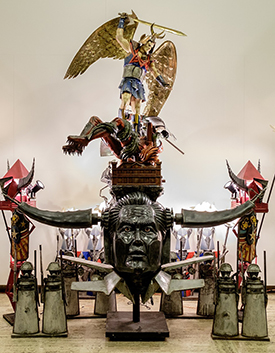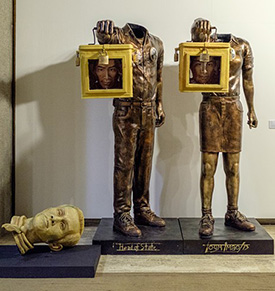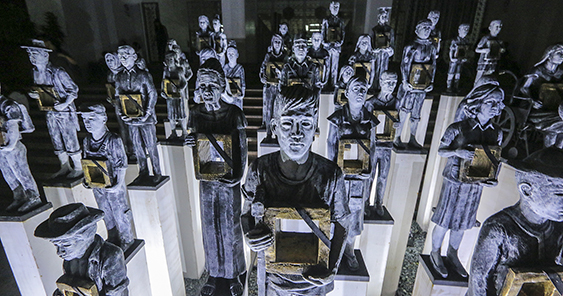Words By Rome Jorge
Photos by Albert Labrador, Al Alarilla, and Fernando Josef
In the era of historical revisionism and resurgent fascism, Toym de Leon Imao designs a nation’s conscience. He is the vanguard of memory. His sculptures give voice to the fallen and they speak with the heartbreaking echo of history.
Sculptors of the past have mythologized leaders with heroic poses and idealized portraits. Many contemporary monument designers have opted for mute neutrality by remembering victims and fallen soldiers with nondescript lists of names engraved on walls as well as reflecting pools and fountains. Imao’s works, on the other hand, unabashedly unveil the hole left by the fallen in our hearts, expose the shameful absence of justice, and unmask the emptiness of minds devoid of historical facts.
The son of the late Dr. Abdulmari Imao Sr., the first Filipino muslim to be conferred National Artist of the Philippines, Toym is a Fulbright Scholar with a Master’s Degree in Fine Arts from Rinehart School of Sculpture at the Maryland Institute College of Art in the United States where he studied the subject “The Visual Culture of the Holocaust.” He was recognized with the Gawad Patnubay ng Sining at Kalinangan from the City of Manila and the Gawad Parangal para sa Sining, sa Larangan ng Eskultura by Quezon City. For all his achievements, it is Imao’s works that speak best for him.
Desaparecidos Reappear
 With ‘Desaparecidos,’ the sculptural installation at the Bantayog ng mga Bayani Memorial Center in Diliman, Quezon City that remembers the victims of the Marcos dictatorship, Imao successfully memorializes absence. “I knew when I was conceptualizing ‘Desaparecidos’ that it would not be a literal in its imagery. And, as with my other works, that there will be several layers of visual metaphors to deliver the narrative beyond the literal,” he notes, adding, “We timed the exhibition of ‘Desaparecidos’ in September 2015, 43 years after the declaration of Martial Law, thus, the 43 figures.”
With ‘Desaparecidos,’ the sculptural installation at the Bantayog ng mga Bayani Memorial Center in Diliman, Quezon City that remembers the victims of the Marcos dictatorship, Imao successfully memorializes absence. “I knew when I was conceptualizing ‘Desaparecidos’ that it would not be a literal in its imagery. And, as with my other works, that there will be several layers of visual metaphors to deliver the narrative beyond the literal,” he notes, adding, “We timed the exhibition of ‘Desaparecidos’ in September 2015, 43 years after the declaration of Martial Law, thus, the 43 figures.”
“I was inspired by photos of concerned individuals holding up pictures of their lost loved ones during rallies, especially on the International Day of the Disappeared. Visually, I depict their disappearance through the empty picture frames. Symbolically, the empty frames are niches, similar to the recesses where dead bodies are placed in morgues. Metaphorically, the empty picture frames, clasped between the chest and the abdominal cavity represent the lost that those who were left behind are feeling.”
“When you look through the empty frame, you will either see more empty picture frames or the faces of the sculptures behind. When there is a big enough space to go around the sculptures, it is also possible to see your own face or the faces of other viewers being framed by the squares, indicating you or me, can also be victims,” explains Imao.
Volt in for victory
 In absolute contrast to ‘Desaparecidos,’ his sculptural series ‘San Voltes V’ and ‘San Mazinger Z’ irreverently bastardizes the Philippines’ devotion to Roman Catholic saints with Marcos’ egocentric portrayal of himself with his gigantic bust in Tuba, Bueguet (demolished by communist rebels in 2002) and his generation’s fascination with Japanese animation television series about giant robots such as Voltes V and Mazinger Z, consequently censored by the Marcos regime.
In absolute contrast to ‘Desaparecidos,’ his sculptural series ‘San Voltes V’ and ‘San Mazinger Z’ irreverently bastardizes the Philippines’ devotion to Roman Catholic saints with Marcos’ egocentric portrayal of himself with his gigantic bust in Tuba, Bueguet (demolished by communist rebels in 2002) and his generation’s fascination with Japanese animation television series about giant robots such as Voltes V and Mazinger Z, consequently censored by the Marcos regime.
“The impetus to make the Voltes V and Mazinger Z installations came from my realization that many in the younger generation (some of the older, too) believe that the Marcos years were golden years. Social media made it easy for the Marcoses and their supporters to spread well-crafted yet misleading videos and articles proclaiming the former dictator as the best president the country ever had. While the anime-inspired installations also dealt with the narratives of Martial Law, they were steeped with ‘playful’ and colorful details, as they featured the excesses and extravagance of the Martial Law years. These attracted audiences who posted photos of the works in social media, raising awareness and at the same time, providing venues for discussions about martial law,” he explains.
 Equally eloquent is Imao’s sculpture ‘Head of State’ where two headless figures hold the iconic ballot boxes that used in the fraudulent snap elections of of 1986 that proceed peaceful People Power Revolt that same year that ousted Marcos. Inside each ballot box is the each figure’s own head.
Equally eloquent is Imao’s sculpture ‘Head of State’ where two headless figures hold the iconic ballot boxes that used in the fraudulent snap elections of of 1986 that proceed peaceful People Power Revolt that same year that ousted Marcos. Inside each ballot box is the each figure’s own head.
Getting personal
To Imao, his work for memorials on the victims of the Marcos dictatorship are deeply personal. “It pains me to visit the graves of two people very dear to me at the Libingan ng mga Bayani—my father [National Artist for Sculpture] Dr. Abdulmari Imao Sr. and [National Artist for Literature] Dr. Alejandro Roces—and see, around 200 meters away, the heavily guarded tomb of the late dictator Ferdinand E. Marcos. They pulled one of the highest forms of institutional historical revisionism on us last year,” he confides.
 “We had family friends who disappeared during the tumultuous martial law years. I still see their families from time to time and the loss of their loved ones is still an open wound,” recalls Imao, and further reveals, “My family was in the opposition in the 1970s. One of my beloved mentors, Dr. Alejandro Roces, was a big part of my political awakening since he was a part of the first large-scale organized opposition against the dictatorship. My father’s family in Mindanao also suffered losses during the martial law era. A few who survived the Burning of Jolo in 1974 joined the MNLF [Moro National Liberation Front]. I had an uncle who was shot and killed in Zamboanga by government soldiers, and he was not even part of the rebellious side of the family.”
“We had family friends who disappeared during the tumultuous martial law years. I still see their families from time to time and the loss of their loved ones is still an open wound,” recalls Imao, and further reveals, “My family was in the opposition in the 1970s. One of my beloved mentors, Dr. Alejandro Roces, was a big part of my political awakening since he was a part of the first large-scale organized opposition against the dictatorship. My father’s family in Mindanao also suffered losses during the martial law era. A few who survived the Burning of Jolo in 1974 joined the MNLF [Moro National Liberation Front]. I had an uncle who was shot and killed in Zamboanga by government soldiers, and he was not even part of the rebellious side of the family.”
Method to Memory
 Those designing memorials have much to learn from Imao. He cautions, “While I love working on historical commissions, it is limiting in the sense that you are bound by your clients’ historical, and sometimes, creative sensibilities. Usually, they want something safe or non-controversial. There were also times when I feel a monument is just a glorified grave marker or merely a ribbon-cutting opportunity. That is why I also try to make art installations that on which I have full artistic and creative control.”
Those designing memorials have much to learn from Imao. He cautions, “While I love working on historical commissions, it is limiting in the sense that you are bound by your clients’ historical, and sometimes, creative sensibilities. Usually, they want something safe or non-controversial. There were also times when I feel a monument is just a glorified grave marker or merely a ribbon-cutting opportunity. That is why I also try to make art installations that on which I have full artistic and creative control.”
Imao reveals his creative process:
“Research is very important. An artist may not be able to satisfy everyone with his creative depiction but the facts that I am basing my interpretations on should be solid. I usually work with historians who provide me with the research I need.”
“I try to avoid making literal interpretations, my works are full of symbolisms as I want to give room for the audience to engage and come up with their own conclusions. For me, the ideal memorial would be one where people can gather together and feel that they can talk freely about the person or the event being depicted.”
“An ideal memorial should not spoon feed the historical narratives it represents but rather it should be a portal for further inquiry and discourse. Artists of such memorials have the responsibility to embody the spirit and emotions of the era of their representation and transcribe it into memory markers embodying contemporary sensibilities of the current times. The artists should also be conscious that whenever he creates a public imagery, it has the potential to become canon, whether that was the original intent or not.”
 Not Waiting
Not Waiting
With today’s fascism enabled by fake news and fake history, the likes of Imao have much more to do. “There are so many things currently happening in our country that may be the subjects of paintings and sculptures in the future. But as an artist, I feel I have to respond in the now, and not wait for everything to be history. I am happy to note that there are also many other artists who feel the same and they channel their anger and frustrations through their artworks.”







